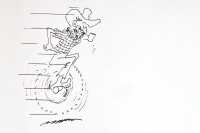A double crested whammy
We were leaving Monroe, La., just after dawn last Sunday, Feb. 19. We crossed over a small levee and dam on Bayou Desiard. There, strung out down the bayou like a flotilla, were 100 or more double-crested cormorants. When I was growing up in northeastern Louisiana, cormorants were either absent or extremely rare. But today these large fish eaters are expanding and/or reclaiming their territory at an alarming rate.
The guns of winter
There was a blast from Vice President Dick Cheney’s 28-gauge shotgun — a gun, by the way, that one Web site touts as “...just right for petite shooters” — and lawyer Harry Whittington was down.
We’ll weather the weather, whatever it is
One of my daughter Izzy’s favorite videos is “Little Bear’s Winter Tales.” She likes the episode with the blizzard. The mantra for the characters becomes, “Whether the weather is hot or whether the weather is cold, we’ll weather the weather whatever the weather, whether we like it or not.” It seems like an appropriate mantra for Western North Carolina.
Cornell – it’s more than just ivory-billeds
Cornell University and the ivory-billed woodpecker have been inextricably linked since the announcement in 2005 of the rediscovery of the ivory-billed in the Big Woods of Arkansas. Cornell Lab of Ornithology (CLO) has embraced that link. It’s featured prominently on its Web site — the last time I checked, it was the most visited segment — and in their solicitations. There is also a bit of an undercurrent out there of skeptics (including me) who feel that Cornell Lab of Ornithology has not provided an airtight case for its claims. Regardless of where you stand on that issue, there is more to CLO than just ivory-billed woodpeckers.
A lone cry of reason from the wilderness
The January 2006 edition of “The Auk,” the journal of the American Ornithologists’ Union, includes a 15-page article by Jerome Jackson, an ornithologist and professor of biology at Florida Gulf Coast University questioning the conclusiveness of the evidence Cornell and partners submitted as proof positive of the existence of at least one ivory-billed woodpecker in the Cache river National Wildlife Refuge in Arkansas.
Trees up close and personal
Winter is a great time for studying tree identification. The mountains look steel-gray from a distance. The forest, up close, is a study in muted earth tones. There’s bark, smooth grey bark, scaly, nearly black bark, fissured gray bark and papery yellow bark to name a few. There are terminal buds, auxiliary buds and lateral buds. Twigs may be hairy (pubescent) or smooth (glabrous). By learning these characters and characteristics, you can turn a winter forest of cold gray and brown timbers into a living forest of black cherry, red maple, basswood, mockernut hickory, Southern red oak, Northern red oak, etc.
Bird nerds unite
I learned, when I worked full-time for the Smoky Mountain News, that it helps if newspaper writers are thick-skinned. It doesn’t matter if you’re writing an op-ed piece, a feature or a news story. There will be someone somewhere who disagrees or doesn’t like it and may resort to calling you names.
Holiday Bird Nerd Diary: Yellow-headed blackbird highlights Balsam bird count
The Carolina Field birders, friends and volunteers conducted their fourth annual Audubon Christmas Bird Count on Thursday, Dec. 29.
A wintry mix
Christmas Day brought showers interrupted by buckets full of sleet. Sometime late Christmas night or before dawn the next morning, a dusting of snow covered the lawn. Winter precipitation is often a mix in the eastern United States. Sleet and freezing rain are almost exclusively eastern phenomena.
Eureka! Dilemma dissolved
I can’t understand how imminent ornithologists, in particular, and biologists, scientists and researchers in general have overlooked the obvious truth regarding the newly rediscovered ivory-billed woodpecker. By borrowing a well established principle from the arena of philosophy and applying it to the biological world it is easy to see the reality here. “Ockham’s razor” a theory named after 14th century philosopher William of Ockham basically states that the best explanation for almost any puzzling phenomenon is usually the simplest one.





